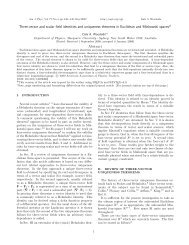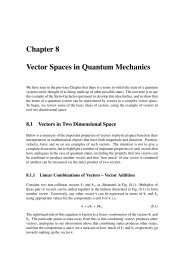Electrostatic Fields in Matter
Electrostatic Fields in Matter
Electrostatic Fields in Matter
You also want an ePaper? Increase the reach of your titles
YUMPU automatically turns print PDFs into web optimized ePapers that Google loves.
This leaves a layer of negative charge on the top surface of thedielectric and a positive layer at the bottom.The orig<strong>in</strong>al charge Q, which was placed on the capacitor plates,is referred to as free charge.The charge <strong>in</strong>duced on the dielectric surface is called bound charge.The bound charge generates a new field, <strong>in</strong> the opposite directionto the orig<strong>in</strong>al field. This new field is called the depolarisation field.The total field <strong>in</strong> the dielectric is the sum of the orig<strong>in</strong>al field (fromthe free charges) and the depolarisation field - it will be smaller thanthe orig<strong>in</strong>al field.Bound chargesFree chargesDepolarisation fieldOrig<strong>in</strong>al fieldLook<strong>in</strong>g at equations (6) and (7), we see that when a dielectricis placed between charged plates which are not connected, then Qrema<strong>in</strong>s constant while V decreases; hence C <strong>in</strong>creases. The factorby which C <strong>in</strong>creases is called the dielectric constant K (or therelative permittivity, ɛ r ).-5
















